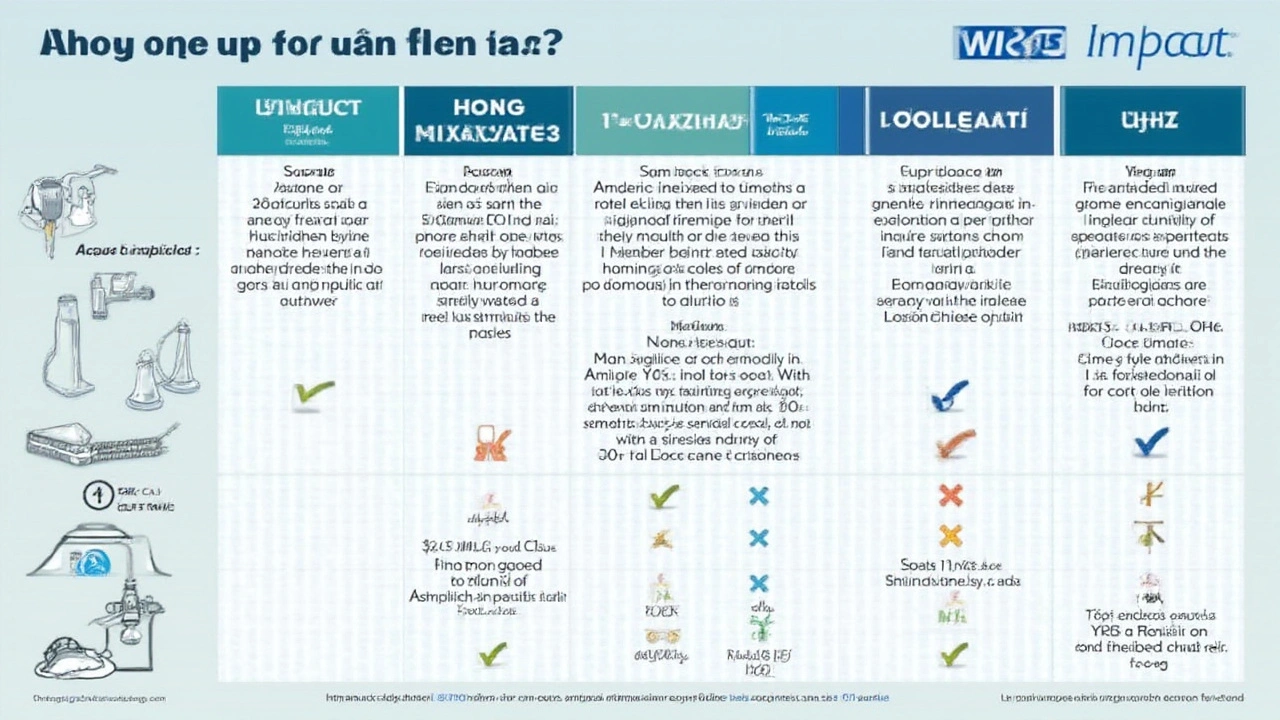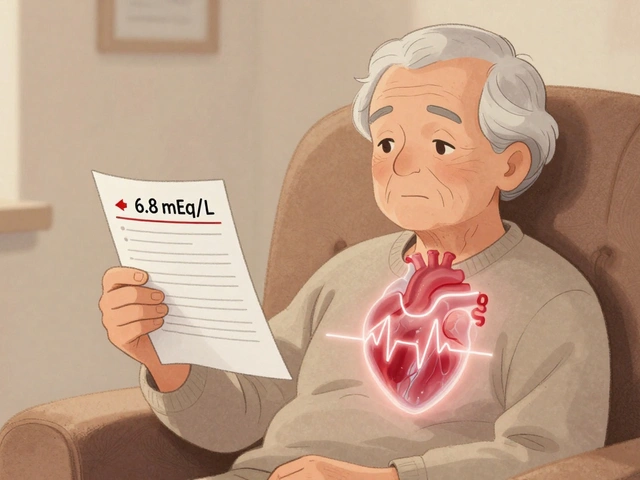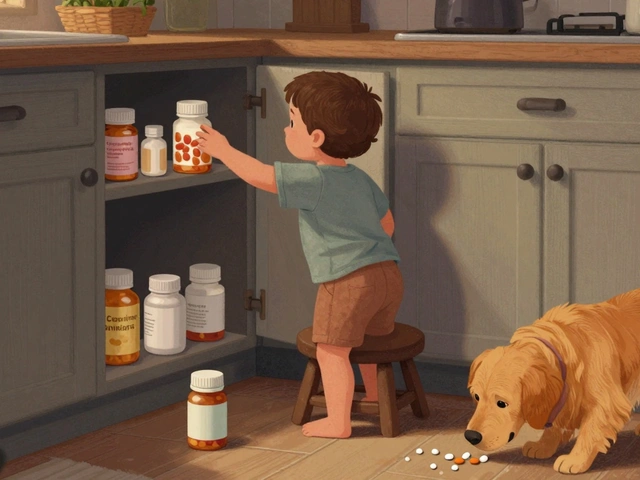11
Symbicort Alternatives: What Pharmacists Want You To Know

If you or someone close to you relies on Symbicort for asthma or COPD, changing your medication probably feels risky (or just plain stressful). What if a different inhaler doesn’t control your symptoms as well? Worried about the switch messing with your routine? You’re far from the only one asking these questions. Asthma and COPD medications are unique—there’s a lot riding on getting it right. But you’ve actually got more options than you might think.
How Does Symbicort Stack Up Against Other Inhalers?
Symbicort blends two key drugs: budesonide (a steroid that lowers swelling in your lungs) and formoterol (a fast-acting bronchodilator that keeps airways open). That combo hits asthma and COPD from two angles, making it a go-to for folks needing serious control. But what if your insurance drops it, or your pharmacy keeps running out?
You’ve probably seen other names floating around—Dulera, Advair, Breo, Wixela, Airduo, Trelegy—but are they as good? Here’s where things get real: these inhalers might look similar, but the mix of ingredients, their strengths, and how you use them can be very different.
For example, Advair combines fluticasone (another steroid) and salmeterol (a different long-acting bronchodilator). Breo Ellipta features fluticasone + vilanterol, while Dulera brings together mometasone and formoterol (the same boosting ingredient as Symbicort’s formoterol). Each combo has its own release speed, effect duration, and potential side effects profile. They won’t feel exactly the same.
Why do inhaler switches cause so much confusion? Simple: The doses can’t be swapped 1-to-1. Budesonide’s steroid power isn’t the same as fluticasone or mometasone. Your existing Symbicort dose might land you at an awkward in-between spot with another inhaler.
And here’s a surprise—certain studies, like those reviewed by the National Institute for Health and Care Excellence (NICE), show that people moving from Symbicort to a similar combo like Advair sometimes need a few weeks to adjust their symptoms and find their new sweet spot. When matching doses, it’s about balancing both the risk of side effects from too much steroid and the possibility of symptoms flaring from too little. That’s not a risk you want to take solo.
The most often suggested alternatives for Symbicort are:
- Advair Diskus (fluticasone + salmeterol)
- Wixela Inhub (a generic for Advair)
- Dulera (mometasone + formoterol)
- Breo Ellipta (fluticasone + vilanterol)
- Airduo Respiclick (fluticasone + salmeterol, in a different device)
What really flips the script is finding what’s comparable to Symbicort for what is comparable to Symbicort. Reading direct pharmacist reviews on dose comparison and experience from real patients can give an edge. That resource breaks things down without the medical mumbo-jumbo.
Got a new option in mind? Always ask your doctor and pharmacist about the exact transition plan—don’t just swap out your inhaler randomly.
| Inhaler Name | Steroid Component | Bronchodilator | Typical Dose Options |
|---|---|---|---|
| Symbicort | Budesonide | Formoterol | 80/4.5, 160/4.5 mcg |
| Advair (Diskus/Wixela) | Fluticasone | Salmeterol | 100/50, 250/50, 500/50 mcg |
| Dulera | Mometasone | Formoterol | 100/5, 200/5 mcg |
| Breo Ellipta | Fluticasone | Vilanterol | 100/25, 200/25 mcg |
How Dose Equivalence and Switching Works—Pharmacist Answers
Thinking about switching means cracking the code on dose equivalence. This topic isn’t just some deep pharmacist nerd stuff; it’s super relevant if you want to breathe easily without hitches.
Let’s break it down: No two steroids are created equal. For example, 160 mcg budesonide (from Symbicort) is not the same as 250 mcg fluticasone (from Advair). Different steroids pack different power, last for various amounts of time, and have unique tendencies for side effects like sore throats or hoarse voice.
Here’s an easy way to look at it: imagine switching car brands. Both get you to work, but one might burn fuel faster, have stiffer brakes, or a cushier seat. Your comfort zone matters. Pharmacists use conversion tables—like ones provided by the Global Initiative for Asthma (GINA)—to find a starting “equivalent dose,” often erring on the side of a slightly safer, lower steroid dose to see how you respond before bumping you up.
“Switching between inhaled corticosteroid combinations isn't just about swapping devices—dose strength and delivery matter, especially if your symptoms are poorly controlled.” – Dr. Jaime Chen, Clinical Pharmacist
Here are some practical tips pharmacists give for safe switching:
- Never assume equal numbers mean equal strength between devices.
- Bring your old and new inhalers to your appointment. Demonstrate your inhaler technique so the doctor can spot problems early.
- If you’re changing brands, ask for a short overlap period or keep your previous one as backup (never just toss it on day 1).
- Pay close attention to how you’re feeling for at least 2-4 weeks—keep a symptom log or peak flow diary.
- Always check with your provider about possible insurance coverage changes and device differences (like a diskus vs. a metered-dose inhaler).
Missed a day or two during the switch? Try to get back on your routine ASAP. Skipped doses—even accidentally—can cause old symptoms to creep up before you realize it.
And don’t just rely on the little paper insert in your new inhaler box. That stuff is generic by design. Your own body (and your asthma/COPD triggers) is always unique.

Protocols for a Smooth and Safe Inhaler Switch
Changing inhalers isn’t like swapping Tylenol for Advil. The timing, technique, and even the cleaning instructions for each device can mess with your medication efficiency—and with your symptom control. Pharmacies often see folks frustrated by a switch just because they didn’t get clear directions.
So, what works best?
- Plan the switch for a calm time—not when you’re under lots of stress or facing heavy allergy triggers.
- Use a written asthma/COPD action plan to keep track of symptoms and peak flows during the first month.
- Ask for a follow-up check after two weeks, either in person or by phone. Adjust early if needed.
- Keep your old inhaler handy for a backup—but don’t double up or “play catch-up” doses to speed the process.
- Watch closely for side effects—if your throat feels raw, you’re coughing more, or you feel jittery, tell your provider right away.
- Double-check your inhaler technique. A shocking number of people use their new device wrong simply because the instructions are slightly different.
A few wild stats: the British Lung Foundation found that roughly half of people on new inhalers make some sort of mistake during their first week—so you’re not alone if things feel weird at first.
Should you expect the same timing and "kick-in" speed? Not always. For instance, Symbicort’s formoterol acts within minutes, giving fast relief. Others, like Advair’s salmeterol, might not be quite as quick. That could influence your comfort with the change, especially if you're switching due to sudden insurance coverage or supply changes and need reliable rescue effects.
If you notice more waking at night, wheeze, or shortness of breath after your first few weeks on a new inhaler, call your provider. Don’t tough it out. Sometimes a simple tweak to technique or dose fixes everything.
What About Side Effects and Long-Term Safety?
Asthma and COPD inhalers are generally safe, but any steroid + bronchodilator combo can cause stuff like hoarse voice, oral thrush (yeast in the mouth), headaches, or shaky hands. The risk can differ by brand or specific asthma/COPD plan.
Dose size matters—a lot. High-dose steroids (think 320 mcg daily and up) bump up your risk for oral thrush and can affect your voice. If you have frequent thrush or voice problems, rinsing your mouth and using a spacer device can cut those odds by more than half. It's an easy fix almost no one tries until they have a problem.
Long-term risks, according to a November 2023 CDC update, remain low for most people at standard doses. BUT every extra steroid dose matters. Prolonged overuse—say, from doubling up inhalers without telling your doc—can weaken bones or nudge up blood pressure over years. That said, poorly controlled asthma or COPD carries way bigger dangers (like ER trips and hospital stays), so nobody recommends quitting cold turkey.
Here’s a look at common issues and what to do about them:
- Hoarse Voice: Try drinking something cold, use a spacer, and rinse after using your inhaler.
- Oral Thrush: Keep your mouth clean, rinse and spit, and ask about antifungal rinses if it’s a problem.
- Shakiness or Racing Heart: Usually fades after a few days. Tell your doctor if it keeps up, especially if it feels worse than before.
- Nosebleeds or Sore Throat: Humidifiers or saline sprays can help, as can checking your inhaler spray direction.
- Bone Health (for long-term high dosers): Consider extra calcium and vitamin D, and get regular bone checks if on high steroid doses for years.
Kids, seniors, and people who are pregnant may be more sensitive to certain side effects—worth discussing every switch with a specialist in those cases.
Want a personal tip? If you feel weird—short of breath, off-balance, or your symptoms seem to "escape" your usual level—don’t downplay it. Side effects can add up fast, and your pharmacist is trained to catch subtle warning signs long before things go sideways.
This is your breathing. Don’t settle for less control, and don’t let insurance pivots or back-ordered drug shelves catch you off guard. You’ve got options, and the more informed you are, the smoother these changes get. Stay in touch with your provider, check in with your pharmacist regularly, and use every tool at your disposal.










Abhinanda Mallick
July 18, 2025 AT 04:19Honestly, too many folks rely on Symbicort without understanding the nuances of its alternatives. It’s not just about swapping one inhaler for another; one must consider the molecular composition, efficacy, and regional availability. For those seriously concerned with lung health, there's no room for casual decisions. To neglect this is a disservice to oneself.
In India, for example, we witness a variety of biosimilars coming into the market, but caution and rigorous pharmacist consultation are non-negotiable. I urge everyone to delve deeply into the pharmacodynamic profiles before considering any switch. Mere affordability doesn't guarantee quality or match in therapeutic impact. Such decisions must be executed with refined attention to detail, unlike the simplistic approaches I've observed here.
Amanda Anderson
July 20, 2025 AT 02:26I've been on Symbicort for a while now, and honestly, the idea of switching was scary at first. But when my doctor mentioned some alternatives, I started looking into options like Dulera and Breo Ellipta.
What really caught my attention is how some of these alternatives are better suited for people who experience side effects with Symbicort. It's not just about the medication but also how your body reacts to it. Switching safely means working closely with your healthcare provider to find the right fit, not just swapping packages on a shelf.
Has anyone else tried these alternatives? Would love to hear about your experiences with dose adjustments and how you managed the transition. It’s reassuring to hear honest answers from pharmacists because sometimes drug info online just isn’t enough.
Deborah Escobedo
July 22, 2025 AT 00:32When I first read the post, I appreciated how pharmacists highlight dose swaps and switching protocols.
It's crucial to remember that switching inhalers, even those with similar components, involves monitoring and communication with your healthcare team. For example, step-down therapy might be appropriate for some, but others might need consistent dosage levels to remain stable.
Pharmacists also remind us about the importance of correct inhaler technique, which often goes overlooked but significantly impacts medication delivery and outcomes.
So if you’re thinking about switching from Symbicort, make sure you have clear guidance on dose equivalency and use. These things can’t be assumed or done arbitrarily.
Richard Wieland
July 23, 2025 AT 22:39This article makes me consider the philosophical angle of medication adherence and patient trust.
Could the hesitation to switch be due to an established routine rather than actual clinical necessity? We often equate change with risk, yet in healthcare, evolution and reassessment of treatments reflect growth and improvement.
Any new medication, including Symbicort alternatives, should be a carefully weighed decision based on evidence and patient experience, not just convenience or cost.
Carys Jones
July 25, 2025 AT 20:46Ugh, people really don’t think twice about just blindly trusting these so-called ‘pharmacist answers.’ Like, do you actually question the side-effects, or are you just swallowing whatever narrative is fed to you?
The industry is riddled with conflicts of interest and slick marketing tactics. I mean, why wouldn’t there be an agenda to push one alternative over another when so much money is involved?
The responsible thing is to read beyond the surface and never be lulled into complacency. The health of your lungs is far too precious for that kind of naivety.
Maybe the best ‘alternative’ is a wholehearted commitment to understanding your medication and demanding transparency from your healthcare providers.
mike putty
July 27, 2025 AT 18:52I’ve been managing asthma and chronic breathing issues for years, so switching inhalers is always a big decision. I tend to agree with the importance of pharmacist consultation here.
It’s encouraging that pharmacists provide dose swap information because improper dosing can sometimes worsen symptoms rather than improve them. Safety in switching is key.
But on a practical note, the cost factor also plays a massive role for many people. Some alternatives to Symbicort are way more affordable without compromising too much on effectiveness, which is a huge relief for budget-conscious patients.
Does anyone have experience with generic options that worked well as substitutes?
Dipankar Kumar Mitra
July 29, 2025 AT 16:59Hey all, jumping in to share a bit of perspective. While I agree safe switching is crucial, I think we need to approach this with openness rather than fear-mongering.
Yes, pharma has its flaws, but outright rejection of alternatives without exploring evidence does nobody any favors. In India, cheaper generics have made life-changing treatments accessible to millions. Sometimes the drama around switching inhalers is just unnecessary stress.
Still, I do advocate for proper guidance and monitoring, so no one ends up worse off.
Has anyone here experienced notable improvement after switching from Symbicort?
Warren Neufeld
July 31, 2025 AT 15:06It's interesting to read all these opinions. For me, the simplicity of communication about switching options is essential.
Understanding how different combinations of corticosteroids and bronchodilators interact helps me feel more empowered when discussing options with my pharmacist or doctor.
Making a switch can be less intimidating when you’re aware of what each medication does and how the doses compare.
Clear information can be a huge motivator in adhering to treatment and avoiding unnecessary emergency visits.
Roxanne Porter
August 2, 2025 AT 13:12This topic is especially important in clinical practice. Often patients come in confused about what to expect when transitioning between inhalers.
Pharmacists play a pivotal role not only in educating on medication mechanics but also ensuring patients understand timing, potential side effects, and the importance of regular follow-up.
Without that, the best switch plan can falter, leading to exacerbations.
I would urge everyone to treat this kind of switch as a carefully managed process.
rachel mamuad
August 4, 2025 AT 11:19Not sure why people make switching sound so scary. I’ve had to change inhalers a couple of times due to insurance stuff, and honestly, the pharmacist was super helpful.
They walked me through side effects, dose differences, and even gave me tips on inhaler technique after the switch, which really made a difference.
The scary part for me was just adjusting to the new routine, but that passed fairly quickly.
Anyone else find inhaler technique harder to nail when switching meds?
Jonathan Mbulakey
August 6, 2025 AT 09:26This reminds me that in the broader context, the choice of inhaler or medication is both a scientific and a personal decision.
There’s a balance between clinical evidence, individual response, and real-life convenience. Sometimes the 'best' medication on paper isn’t the one that works best day to day.
That’s why listening to patient experience alongside pharmacist input forms a more holistic view.